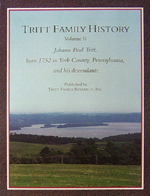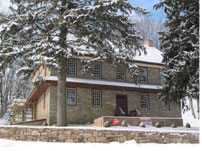|
Excerpts from December 2006 Issue of Tritt Family
Newsletter
 After years of research, the second volume of Tritt Family History is finally complete. As we have reported before, the design for Volume II has changed from our original intentions. We had planned on report all of the descendants of Hans Peter and Christian Tritt in his volume. In 2004, we concluded that this was too great an undertaking for a single book and that each family line should have its own volume. This would allow more details to be given about many of our ancestors and expedite the process of releasing data on family lines already completed. We had first thought that each of these books would be short when compared to Volume I, but as Volume II came together, we saw that it would be of comparable length to the first installment and could stand on its own as a full volume. Volume II will match Volume I in both layout design and binding quality. This hard cover format is durable enough to last for decades to come so that future generations can gain an appreciation of their roots through these books. After years of research, the second volume of Tritt Family History is finally complete. As we have reported before, the design for Volume II has changed from our original intentions. We had planned on report all of the descendants of Hans Peter and Christian Tritt in his volume. In 2004, we concluded that this was too great an undertaking for a single book and that each family line should have its own volume. This would allow more details to be given about many of our ancestors and expedite the process of releasing data on family lines already completed. We had first thought that each of these books would be short when compared to Volume I, but as Volume II came together, we saw that it would be of comparable length to the first installment and could stand on its own as a full volume. Volume II will match Volume I in both layout design and binding quality. This hard cover format is durable enough to last for decades to come so that future generations can gain an appreciation of their roots through these books.This has been a group effort involving Tritts from several lines of descendancy. We would like to thank Don and Richard Tritt for the preface and introduction respectively. Leonard and Connie Tritt, Jan Klinedinst and Jane Ward all joined us as chapter authors. A special thanks should go out to Mercedes Woolsey who compiled the research of cousins and other relatives into the final genealogical data section. Donald Tritt of Ellwood City, PA and his cousin, Eric Carothers, of California, contributed to the family stories and data sections. Volume I told the story of the earliest known Tritts in Switzerland and the emigration of Hans Peter and Christian Tritt to America. In Volume II, the story continues as Johan Paul Tritt, son of Hans Peter, carves out a life of colonial Pennsylvania. Paul labors as a blacksmith to support his growing family and finds himself in a Revolutionary War militia helping to turn the tide of that historic conflict. The genealogical data section contains over 1,000 names including over 700 known living descendants. These descendants have spread all over the United States including Washington, California, Colorado, Missouri, Nebraska, Indiana and Hawaii, with heavy populations found in Utah and western Pennsylvania. Some descendants have even been found as far west as Korea and even back across the Atlantic to Sweden. We have compiled stories of several of Paul's descendants. We have the story of Paul's last child Henry who was alienated from his family and suffered an unfortunate early death. From personal journals and autobiographies we have found details of women who braved the developing west of the early 1900's. We also have detailed account of the World War II bravery of Harold Hegyessy which went unrecognized for too long. There is also an account of a mining accident in southwestern Pennsylvania, and more. This volume promises to be a valuable addition to your Tritt Family Research collection and the Tritt Family History series. Whether the people in this volume are your direct ancestors or your distant cousins, they are all family. We hope you will enjoy learning more about the Tritt family tree, roots, branches and more. Order yours today.
 On March 20, 2006, the staff of the Cumberland County Historical Society visited the Dritt Mansion along the beautiful Susquehanna River at Long Level, York County, Pennsylvania. We had visited the house several years earlier during the early stages of the restoration of the mansion and returned again to see the completed project. The purpose of this article is to update readers as to the current status and use of the property. On March 20, 2006, the staff of the Cumberland County Historical Society visited the Dritt Mansion along the beautiful Susquehanna River at Long Level, York County, Pennsylvania. We had visited the house several years earlier during the early stages of the restoration of the mansion and returned again to see the completed project. The purpose of this article is to update readers as to the current status and use of the property.The building is now known as Pleasant Garden. This new name comes from the first owner of the property, Thomas Cressap, who obtained the land in 1729 by Maryland land grant from the fifth Lord Baltimore. Cressap named the 150 acres of land Pleasant Garden and also operated a ferry across the Susquehanna River, which he named the Blue Rock Ferry. During this time period, land up to the 40th parallel was the northern boundary of Maryland. Over time, this property has been owned by eleven different owners, including: Thomas Cressap (1729), John Meyer, Jacob Dritt, Margaret Dritt Bonham, Jacob Detwiler, David March, Barton Gnaw, Byrd Liebhart, Kenneth Wallick and John and Kathryn Zimmerman. The Dritt (Tritt) Family owned the property for many years and the name Dritt Mansion became associated with the dwelling when it was placed on the National Historic Register. The first floor of the mansion is occupied by the Lancaster-York Heritage Region office (LYHR). LYHR is a non-profit organization, which is designated Pennsylvania Heritage Area that helps identify, preserve, interpret and promote the rich heritage and culture of Lancaster and York Counties. You can visit them online at www.lyhr.org. When you visit the mansion you will find their office and conference room on the first floor. Visits to the second floor and basement require permission and a tour guide. A brochure about the mansion is available that contains some new information about the property. The house is now dated circa 1738. There are several carpenter and protectorate marks and some writing in the attic that help to date the house. Archaeological findings suggest that there was a structure that stood on the site previous to the mansion. Foundations were discovered beneath the first floor. The summer kitchen had fallen down overtime and was also discovered by archaeological diggings. It has been faithfully rebuilt on its original location. Some say that the mansion is an English Castle (a two and a half-story, stone dwelling). In fact, the mansion has English and German influences in its design and architecture. It is 50 feet long and 40 feet wide. There are four fireplaces in the main part of the house (two upstairs facing east and two downstairs facing west), which was quite practical for heating, especially since Franklin Stoves or ceramic heaters allowed to heat to flow into the adjacent room. Over time, changes to the house occurred, such as replacing the floor boards, adding gas and electricity, replacing windows with doors and doors with windows, and changing the front porch and pent roof. The bluestone on the outside of the house is original; it only needed to be re-pointed. Keeping with the historical integrity, the house was updated for 21st century living. The archeological work also resulted in the finding of thousands of artifacts, including: coins, glass, pottery, leather, buttons, hardware, personal effects and prehistoric artifacts to name a few. After close examination of the basement, evidence points to it being used for food storage, animal butchering, fish preparations and alcohol making. Bullets and gun flints were also found on site, suggesting fighting either with Native Americans or during the Border War. The artifacts are being catalogued by Jan Klinedinst and will become the property of the Pennsylvania State Museum and Historical Commission. It was always exciting to visit the historic two and a half-story stone mansion, but a visit now is even more special after the completion of the five-year restoration and renovation project. This was a true labor of love for the owners, John and Kathryn Zimmerman. It is a dream come true for members of the Tritt family to see life again in the mansion, after seeing the building empty and deteriorating for so many years. Future generations will certainly benefit from the Zimmermans' foresight and generosity.
From
the President / Meeting
Dates & Events / Newsletter / Family
Records Form / Special Offers
Tritt Family History - Volume I / Tritt Family History - Volume II /Tritt Family History - Volume III / Tritt Family History - Volumes IV Tritt Family History - Volumes V & VI / Tritt Sale Items /Mailing Addresses / Appeal for Patron Donors contact via email trittfamilyresearch@comcast.net
WEBSITE
AND ITS CONTENTS ARE ©TRITT FAMILY RESEARCH, INC.
|
